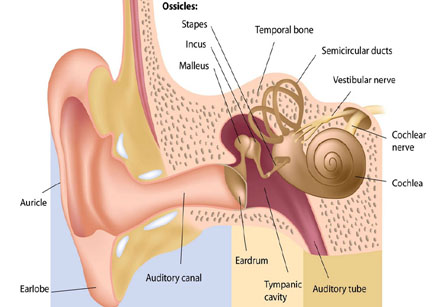Ear Tubes
Introduction
Ear tubes are made from plastic and shaped like a hollow spool. The ear tubes are suggested by doctors for children who suffer from repeated ear infections or when fluid tends to stay behind the eardrum. A ENT specialist (otolaryngologist) places the tubes through a small surgical opening made in the eardrum or (myringotomy or tympanostomy). The child is unconscious under general anesthesia for this surgery.
Tubes can reduce ear infections because of various reasons. They include:
• Allow air entry in the middle ear.
• Allow drainage of fluid out of the middle ear through the tube into the ear canal.
• Tubes clear fluid from the middle ear and also restore hearing.
• Prevent future buildup of fluid in the middle ear.
• Reduce the feeling of pressure in the ears, which reduces pain.
An ear tube creates an airway that ventilates the middle ear and prevents the accumulation of fluids behind the eardrum

After the surgery:
Tubes can be inserted as an outpatient surgical procedure. Recovery in children is usually quick and usually there is no pain or other problem after surgery. Children can usually go home within 1 to 2 hours after the surgery. The child can probably return to school or child care on the next day.
Follow-up visits to the doctor after insertion of tubes are very important. The doctor examines the ear to see whether the tubes are working and whether the child’s hearing has improved.
The child needs to take extra care while the tubes are in place. Keep water from getting in the ear while bathing, showering or swimming. The ear can get infected if any germs in the water get into the ear. The child can use earplugs if the doctor allows it. The doctor can tell you when the hole in the eardrum has healed and when regular water activities can be resumed.
Tubes normally remain in the ears for about 6 to 12 months. They often fall out on their own. If the tubes don’t fall out on their own, a surgical procedure may be needed to remove them. After the tubes are out, the child should be watched carefully for signs of ear infection or fluid behind the eardrum.
Indications:
• Placing tubes in the ears drains the fluid and restore ventilation of the middle ear. Tubes may prevent recurrence of ear infections. They also keep fluid from building up behind the eardrum. A surgery to insert ear tubes may be considered:
• If a child has had fluid behind the eardrum in both ears for more than 3 months
• If a child has significant hearing loss in both ears.
• If a child has repeated ear infections.
Results:
Ear tubes often restore hearing. They often prevent buildup of pressure and fluid in the middle ear. They can also reduce pain.
Tubes may keep ear infections from recurring while the tubes are in place. But infections may return after the tubes are removed.
Risks:
• There is a possibility of minor complications in up to half of the children who have tubes inserted. Common complications can include:
• Thickening of the eardrum over time – These changes in the eardrum may affect hearing in a very few cases of otitis media.
• Discharge of pus (otorrhea) from the ear – This is common occurrence and can become an ongoing problem in some children.
• Other possible complications:
• Blockage of the tube, allowing ear fluid and infections to recur.
• The tube may slip out of place and can possibly fall into the middle ear. This is very rare.
• Tissue may form behind the eardrum (cholesteatoma). This is also rare.
Other considerations:
Some children who have tubes inserted may need to undergo a repeat surgery to have the tubes reinserted.
There may be scarring of eardrum due to the tubes. This may lead to minor hearing loss.
After surgery, a child needs regular follow-ups to check whether the tubes are working. In some cases, the child may need antibiotics to prevent or treat infections.